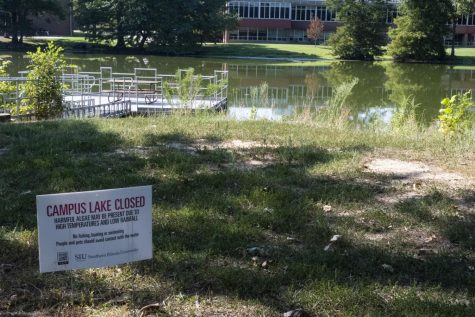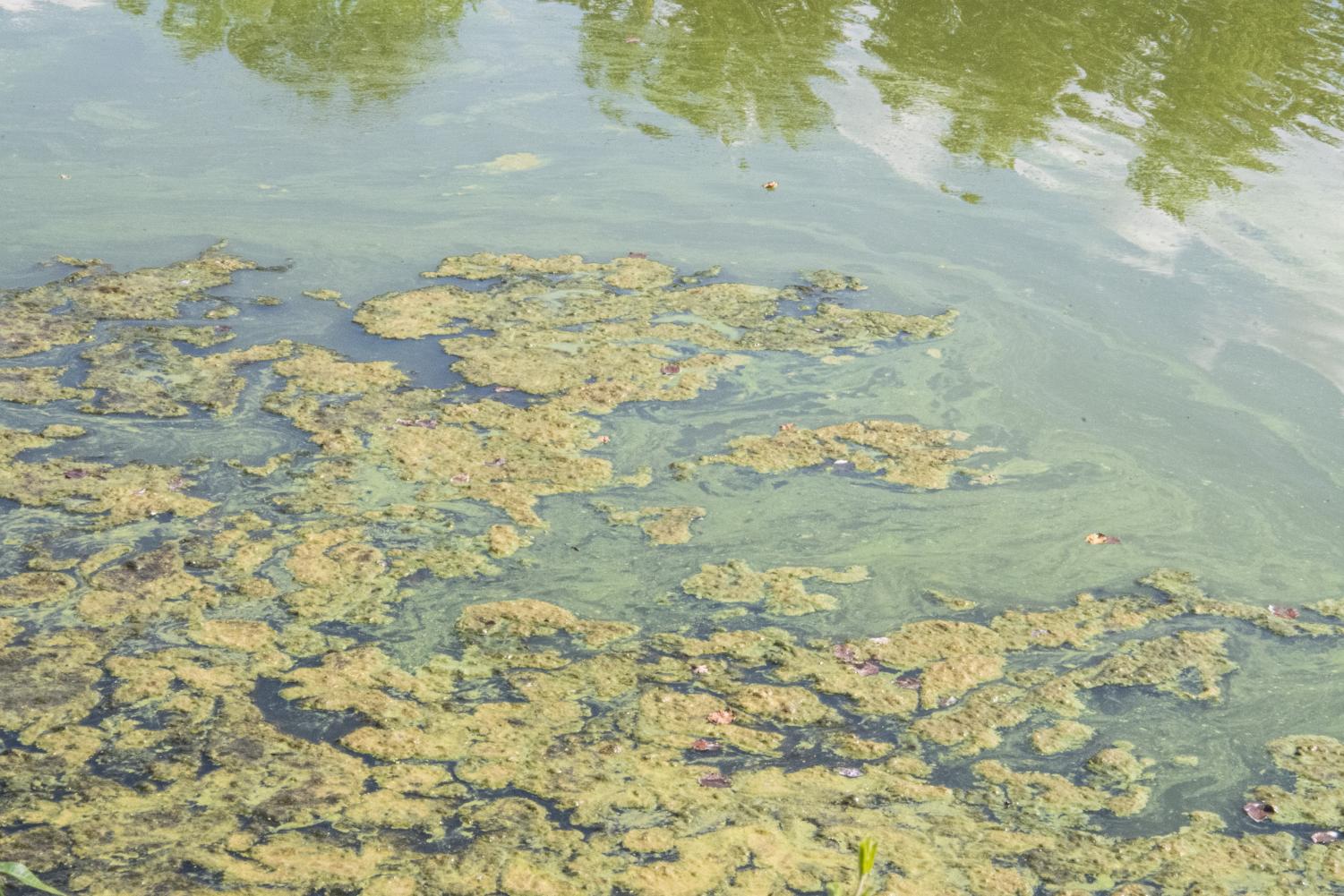Studying the algae in Campus Lake
September 2, 2022
Southern Illinois University’s (SIU) Campus Lake has closed once again because of harmful toxins coming from the algal blooms in the water.
The lake has had to close multiple times over the past several years because of how dangerous the algae in the water is.
According to the Illinois Environmental Protection Agency (IEPA), the algal blooms, caused by the explosive reproduction of cyanobacteria, occur in Illinois lakes and streams and are produced rapidly in warm shallow water that gets a lot of sunlight.
Advertisement
The blooms make stains on the water and float on the surface near the shorelines and typically happen in the summer months.
Zoologist Dr. Majorie Brooks and microbiologist Scott Hamilton-Brehm have been studying the campus lake algae for years to see how it forms and how it releases harmful toxins.
“As soon as the lake water warms above about 30 degrees Celsius, or 86 Farenheit, I don’t know if you’ve ever put your foot in campus lake but it’s like stepping into a bathtub, that warm,” Brooks said.
With the lake being very shallow and in a non-windy environment, the water tends to be stagnant mostly in the arms of the lake, she said.
Brooks said she collected water samples near the start of the school year to do a tracer study so she can determine the level of phosphate.
“That high phosphate is coming into the lake, so the lake has 23 storm drains,” Brooks said. “We know that some of them drain surface waters from campus, runoff from various parking lots and so forth.”
Brooks said the last time the school drained the lake halfway to clean it was in 2016. They cleaned out 23,000 tons of dry algae, testing it for contaminants and giving it to a local farmer to use as fill on his farmland.
Advertisement*
“It’s actually not always an evil thing,” Brooks said. “It’s only [a] problem for society when it builds up to this extent and with climate change, it’s getting worse.”
With the school needing donations for the fountains, Brooks and Hamilton- Brehm are looking into the ecology and biochemistry of the organisms to see if they can find a way for the algae to release fewer toxins, she said.
Books said Facilities and Energy Management and the administration have been trying to find ways to improve the situation, one of them being adding a few fountains.
“We have to think about prevention of the cyanobacteria blooms, so that means oxygenating the water and lowering the nutrients,” Brooks said. “When you add fountains, it also helps cool the water, so that helps prevent that bloom.”
Brooks said it’s also something difficult to clean up since cyanobacteria is a single-celled organism that floats on the surface of the water.

(Saba Saboor Rooh Mofrad | @ssaboor_)
“If you go out there with a rake in the campus lake, it’s just these cyanobacteria are floating, they just slide right through,” Brooks said. “People are actually starting to develop some, if you will, like surface water weed eaters to be able to go out.”
Making big changes to the lake would be nice but severely expensive, Brooks said.
“Chang[ing] the shape of the lake to lower it, deepen it, so dig out the depths and make it much deeper and also to put wetlands,” Brooks said. “Large wetlands in all of the arms of the lake… that’s something that is on the table for consideration.”
Brooks said it would take a lot of resources and heavy equipment to put in wetlands, but overall it would be a very effective form of treating the water.
“There are some cities that treat their municipal water waste through wetland water treatment and have been doing so for a long time,” Brooks said. “So we have some models out there, [but] what we really needed is some really high-level funding to be able to do that in certain areas of life.”
Brooks said the Campus Center for Environmental Health and Safety tests the water during the summer every week for its toxin level. If the water is below 10 micrograms per liter level then it’s safe.
If it’s higher than 10 micrograms per liter level the center can call the IEPA to do a more conclusive test.
Hamilton-Brehm said cyanobacteria is an important organism to study with its effect on the world.
“I specialize in extreme organisms and the cyanobacteria are some of the extremist organisms,” Hamilton-Brehm said. “They’re some of the original organisms that started terraforming this planet, producing oxygen, and all that.”
Hamilton-Brehm said not all cyanobacteria produce toxins and the production of the toxins isn’t entirely unknown.
“You don’t want animals, pets like, drinking the water and all that there’s a lot of nasty effects,” Hamilton-Brehm said. “What happens is, it’s a phosphatase inhibitor, that affects our liver, and so, as animals, you know, dogs, cats, humans, whatever… that it starts, this toxin starts, [that’s] really damaging [to] our liver and so that’s bad news.”
When the toxin levels get high in the water, it becomes very dangerous for humans to be around, but the organisms that already live in the water aren’t usually affected, Hamilton-Brehm said.
“It’s not amenable to humans so, you don’t want to be sticking your hands in it, you don’t want to drink it, you don’t want swimming in it,” Hamilton-Brehm said. “It’s just not a good place for mammals, and fish and other organisms, they deal with them on a regular basis.”
Hamilton-Brehm and Brook’s research is ongoing as they continue to find a way to slow the toxins in the algae down with encouraging results.
“They’re in a beaker and as you can imagine trying to scale up from a beaker to a lake takes many, many steps and a lot of very careful scientific investigation,” Brooks said. “But we have had some positive results and we’re very encouraged.”
Staff reporter Jamilah Lewis can be reached at jlewis@dailyegyptian.com or on Twitter @jamilahlewis. To stay up to date with all your southern Illinois news, follow the Daily Egyptian on Facebook and Twitter.
Advertisement



